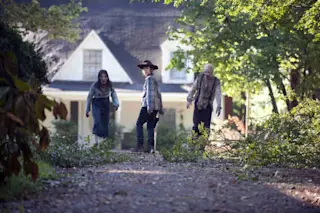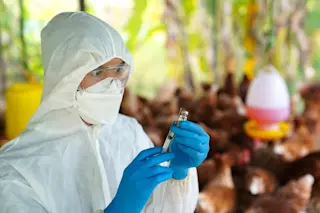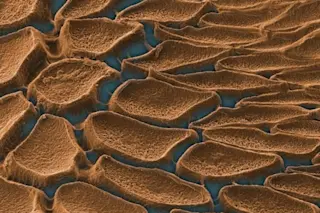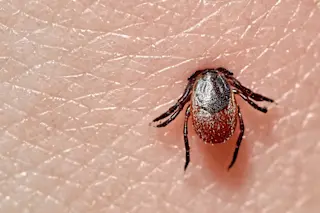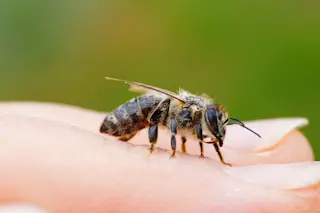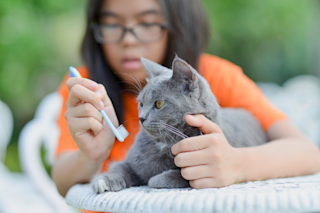Photo by Gene Page/AMC The virus in The Walking Dead makes no sense. As the show stands atop the corpses of many zombie entertainment pieces dead and gone, it seems to have taken on more than it can chew, per say. Like every other zombie-themed frightfest, The Walking Dead adopts Rule #1 of the apocalypse: Don’t. Get. Bit. Why? Because every zombie mouth is filled with the virus that destroyed humanity. Even a scratch will put the pathogen in your blood stream, and unholy reanimation soon follows. This is the part that makes scientific sense. In the study of infectious diseases, epidemiologists would call zombies the virus’ reservoir. That is to say, there is a virus that resides within the zombies, causing them little to no damage, which can be passed to another host. For example, the reservoir of herpes B—a lesser known but much much more deadly herpesvirus—is found in macaques. It can mildly irritate the monkeys but kill nearly 70% of the humans it infects. Most undead narratives end the rules here. Zombies have a virus that can be transmitted through blood and bites…stay away from these. But The Walking Dead goes further for the sake of an interesting story. And how far they go leaves only one scientific alternative—zombie venom. At the beginning the second season of the show, we learn that everyone is infected already. All the characters on the show are carriers of the zombie virus, which presents itself upon death. If you die, you turn. If you get bit, you turn. If you think about it scientifically, it’s confusing. It goes back to reservoirs. When an animal is a reservoir for an infection, they don’t present the disease. The macaques that carry the deadly herpes B virus don’t die horribly from herpes B. Similarly, following what we know about viruses, a human that already carries the zombie virus would not die instantly from another injection of it. If everyone in The Walking Dead already carries the virus, getting bit would be just a bite. You can’t infect the infected. But you could envenomate them. Dead bodies are dirty. Shortly after our body stops fighting off bacteria and starts decomposing, we are colonized by microscopic critters not safe for the living. For example, the state of a corpse is dangerous enough that crews searching for victims of natural disasters take special precautions to make sure they don’t get infected. A rotting body can still transfer gastrointestinal pathogens, tuberculosis, and hepatitis [PDF] to the living. Tuberculosis itself can survive in a corpse for 36 days after host death. So, one can imagine that a biting mouth of a rotting corpse, continuously chomping down on humans, isn’t the most hygienic place. It harbors a cocktail of bacteria and viruses that could be considered a sort of “zombie venom.” Keep in mind, “zombie venom” is my general term for specific bacteria or viruses in the mouth of a mindless attacker that gets injected into you and messes you up. Actual venom is more complex than that. The venom that oozes from the glands of some snakes, for example, is made of proteins, and is the result of a million years of complicated and fascinating evolution. Even so, the result is the same. When a zombie chomps down on you in The Walking Dead, it’s a death sentence. Because a reservoir for a virus doesn’t die from the virus it already carries, what kills a Walking Dead character must be this “venom” made up of bacteria and other viruses associated with decomposing corpses. Without any antibiotics, access to working hospitals, or medical training, the bite is effectively venomous. We have to label it this way because although bacteria and viruses are literally everywhere, only the organisms that live in the saliva in zombies seem to kill. When Rick has a non-zombie inflicted open wound, he survives. Scientifically, I’m making a few jumps in logic here. But infection and viral transmission are health problems we understand the basics of, and their interpretations in The Walking Dead are simply at odds with what we know. For example, if the zombies were the reservoir for a virus that also kills people—as the show implies—pretty much any contact with any surface even near a zombie would be deadly. It would practically be the Middle Ages—scraping your wrist on some sharp outcropping would be the last thing you ever do. Adding insult to zombie injury, complicating the aspects of infection hardly adds any value to the Walking Dead narrative. The death-to-reanimation scenario was used a few times in the show to little effect, and though it was a major reveal in the second season, it didn’t really change anything. There are already zombies everywhere, adding more with any kind of fatality is just more of the same. One of the few times the show’s backwards notion of viral infection actually worked was when a deadly influenza-type virus swept through the group of survivors, killing and therefore zombifying many. But in those few episodes, the scariest part was who was going to get infected. It was the reality of being powerless to fight an invisible foe that added to the narrative, not the made-up rules of becoming undead. When The Walking Dead decided to mutate the virus trope of modern zombie stories, I think they created more confusion than clarity. Questioning fans are right to find it odd when a virus supposedly kills a human that already carries that same virus. Like it or not, science fiction typically needs to bend but not break the laws of science to contribute to the genre. A sort of zombie “venom” made of bacteria and viruses unrelated to the outbreak would do just that. Maybe the show was strapped for scientific concepts and had to inject every plot point into the same vein. Maybe scientific accuracy was sacrificed for “better” storytelling (which sometimes is OK). But if you want to make the zombie apocalypse feel real, complete with CDC analyses and homespun rules of viral transmission, you can’t circumvent virology itself. -- Part of this post was adapted from an earlier post linking zombie mouths—incorrectly—to komodo dragons. I have taken out that part, as komodo dragons do not kill with dirty mouths, but actual venom! If you want to read a great book filled with stories and the science behind human infectious disease, check out David Quammen’s Spillover.
‘The Walking Dead’ Zombie Virus Makes More Sense As Venom
Explore the science behind The Walking Dead virus and how it compares to real infectious disease studies. #ZombieInfectionTransmission
More on Discover
Stay Curious
SubscribeTo The Magazine
Save up to 40% off the cover price when you subscribe to Discover magazine.
Subscribe

